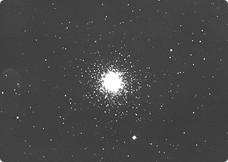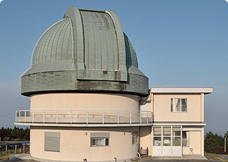It was in 1953 that the Tokyo Observatory*1 approached Nikon about the manufacture of a large 36-inch*2 (91-cm) telescope. Since the largest telescope that Nikon (Nippon Kogaku at that time) had been involved with prior to this was a 20-inch (50-cm) reflecting telescope in 1922, the company suddenly found itself having to gear up substantially to overcome the difficulties involved in building a 36-inch (91-cm) model. Taking up the challenge of this demanding task were two young men, one an astronomer the other an engineer.
- *1The Tokyo Observatory:
constructed in 1888, it became the National Astronomical Observatory in 1988. It was incorporated in 2004, becoming the National Astronomical Observatory of Japan. - *2Inch:
unit that is often used in the field of astronomy to denote telescope size. 1 inch = 2.54 cm.
The two men who worked together on the project, Professor Hiroki Kosai, director of the Saji Observatory, and Nikon Senior Counselor Mr. Shoichiro Yoshida met up again for the first time in a long while to talk about the good old days. Following are extracts from their fascinating conversation.

- Mr. Hiroki Kosai (at right)
- Formerly assistant professor at the National Astronomical Observatory of Japan. Currently serving as director of the Saji Observatory and chairman of the Ministry of the Environment's Stargazing Society. Author of the "Tales of Heavens in the Shakespeare's Drama" as well as of numerous specialist and introductory works on astronomy, and an active lecturer.
- Mr. Shoichiro Yoshida (at left)
- Joined Nippon Kogaku K.K. (now Nikon) in 1956. After working on the design of astronomical telescopes, he developed semiconductor photolithography equipment. He became president of the company in 1997 before assuming the posts of chairman and CEO in 2001. He currently serves as a Senior Counselor to the company. (Photograph: Dodaira Astronomical Observatory)
The Large Telescope Project
It was in 1953 that the Science Council of Japan voted for the establishment of large telescopes and made its request to the government. A special budget was then appropriated for the large telescope project, the plans for which were formulated under the leadership of Yusuke Hagihara, the director of the Tokyo Observatory, and work began to turn these plans into reality. The plan called for the import of the main 74-inch (188-cm) reflecting telescope and for domestic production of two 36-inch (91-cm) auxiliary telescopes. The search for installation sites took two years, and it was decided to locate the 74-inch (188-cm) telescope and one of the 36-inch (91-cm) telescopes on Mount Chikurinji in Okayama prefecture. The criteria for the location of the remaining 36-inch (91-cm) telescope were that it should be close to the Tokyo Observatory in Mitaka city, that it should be sited at the top of an isolated mountain, and that the visibility should be good.
Kosai:Starting in the spring of 1956, I made walking tours of the Chichibu mountain system, from Yokote to Mount Kasa. The leading candidate for the site was Mount Dodaira, which was flat at the summit according to the Geographical Survey Institute's maps and which constituted an excellent triangulation point. There was no path to the summit, and climbing the mountain involved considerable effort to push aside the scrub. Photographing the night sky from the summit, at an altitude of 876 meters, revealed that there was no need to worry about brightness. In the direction of Chichibu the zodiacal light was clear. Later, I climbed up with a heavy 4-inch (10-cm) refracting telescope made by Nippon Kogaku K.K., to assess the visibility and clarity. As a result, the location was judged suitable for observation and Dodaira was selected.
At that time no Japanese company had ever manufactured a 36-inch class telescope.

36-inch (91-cm) Reflector for photoelectric photometry
Type: Cassegrain reflecting telescope
Equatorial mounting: Fork type
Cassegrain focal length: 12 m, F/13
Installed at the Okayama Observatory in 1960

36-inch (91-cm) Reflector
Type: Cassegrain reflecting telescope.
Equatorial mounting: English type
Cassegrain focal length: 16.5 m, F/18
Installed at the Dodaira Observatory in 1962
Kosai: In those days we were intent on doing so in the hope that the task would be turned over to a domestic manufacturer. Nippon Kogaku K.K. was far and away the best candidate for the job. It was decided to make the 36-inch (91-cm) telescope a purely domestic product; however, just two components, the photo-multiplier tube*3 and the grating*4, still had to be imported. We later requested that the grating be turned over to domestic production.
Yoshida: I was very lucky to be given the job of developing the ruling engine*5, a device for fabricating the grating. The experience I acquired in doing so led on to working on steppers.
- *3Photo-multiplier:
photo-electric element for sensing weak light. Since in those days this was a valuable item that could only be obtained through the US military, it is said that they were stored in a safe. Subsequently, photo-multiplier manufacture progressed in Japan, to the point where Japanese photo-multipliers are now as good as any in the world. Photo-multipliers were used in the Kamiokande detector, resulting in the first ever successful detection of neutrinos. - *4Grating:
an optical device used to separate light into its spectral components. - *5Ruling engine:
ultra-precise processing device for engraving minute grooves. It is used in the manufacture of gratings.
Development of the 36-inch (91-cm) Astronomical Telescope

Casting of optical glass: A new technique—a casting process—was developed for the manufacture of the large-scale mirror blank.
When the decision was taken to award the order to Nikon, the resources of the entire company were mobilized in the effort to bring the project to fruition. As a glass specialist, company president Masao Nagaoka was fanatically committed to the manufacture of glass in large dimensions, and took charge of the development of a new technique known as the "glass casting method." In terms of facilities, various investments were made; for example, a new building (now Ohi Plant Building 118) was constructed and a new large grinding machine for large-diameter mirrors was manufactured.
Yoshida: When I joined the company in 1956, I was assigned to the First Design Department and was immediately put in charge of the 36-inch (91-cm) telescope. I think I was brought in to strengthen the design team, as the company had received the order for two large astronomical telescopes. The designers had to undertake a wide range of tasks, such as determining the specifications of components whose purchase involved procurement through negotiation with other companies, and this represented valuable experience for me. This was probably where I got my real training, and it served me in good stead later when I led the stepper project.
Kosai: I visited the Oi factory frequently in those days to attend meetings.
Yoshida: According to the records, meetings started taking place in May 1959. The design involved reviving wartime technology. A senior colleague who was knowledgeable about command equipment*6 advised us to use a self-synchronizing motor for positioning purposes. When you finish the blueprints and take them to your superiors, they order you to change it here and there. You redraw the plans and take them back again. We start off by repeating this process over and over again, but when we come to finish the design, malfunctions emerge here and there, and it is in the process of rectifying them that we learn on the practical level. Debugging after installation is a long drawn-out process.
- *6Fire control system:
a computer which analyses measurement data for the target position and calculates the data necessary to fire a gun or a torpedo, plus the set of command transmission systems that is included with it.

Heat-resistant glass: the 91-cm main mirror blank, manufactured using the casting process, weighed 290 kg and was the largest molded glass object to have been produced in Japan.
Kosai: Everyone did it without grumbling. Our resolve was quite strong back then. We just did whatever it took.
Yoshida: We retrofitted a handle to the exterior of the cell casing for the main mirror at the secondary focus of the telescope after installing the telescope at Dodaira so that it would not slide off the elevator platform during observation. This was intended to fix the trouble that had arisen at Okayama, where the first telescope had been installed earlier. At Okayama, the image was shaped like a rice ball, due to the maintenance methods used on the main mirror. Another problem was that the noise was terrible because they had used a spur wheel for gear reduction in the declination axis. We made use of this experience, employing a counterweight and using a worm wheel on the telescope at Dodaira.
The Guiding Telescopes
Professor Kosai had particular thoughts on the guiding telescopes attached to the 36-inch (91-cm) telescope at Dodaira.
Kosai: The images from the 6-inch (15-cm) guiding telescopes for the Dodaira telescope were unforgettable. The most common reaction was "Wow—that's incredible!". You actually felt the photons striking your optic nerve. I think that this was the telescope at work.

The open cluster M11 (NGC6705) in Scutum, photographed using the 36-inch (91-cm) astronomical photographic reflecting telescope at Dodaira.
Photograph supplied by Hajime Shibasaki

Guiding telescopes
Type: refractor
Objective lens: achromat
Diameter: 15 cm
Focal length: 2.25 m
Two guide telescopes are attached on opposite sides of the main mirror tube. Professor Kosai greatly admired the images that were visible through these telescopes.
Nikon's Contribution

The Dodaira Observatory today. It is possible to stay overnight inside the observatory. There is also a campsite in the surrounding area.
Professor Kosai made the following comments.
Kosai: It is Nikon that has supported astronomy in Japan. I believe that, without Nikon, astronomy in this country would not have attained its current level of development, and for this I am grateful.
It was not necessarily wise to think of the large astronomical telescope from the point of view of commercial profit. However, Nikon improved its technology and trained its personnel in the course of carrying out the project.
The Dodaira station of the National Astronomical Observatory was closed at the end of March 2000 and the role of the Dodaira 36-inch (91-cm) telescope in astronomical research came to an end. This 36-inch (91-cm) telescope and the observation dome were turned over to the local town of Tokigawa and have been opened to the public as a community facility.

